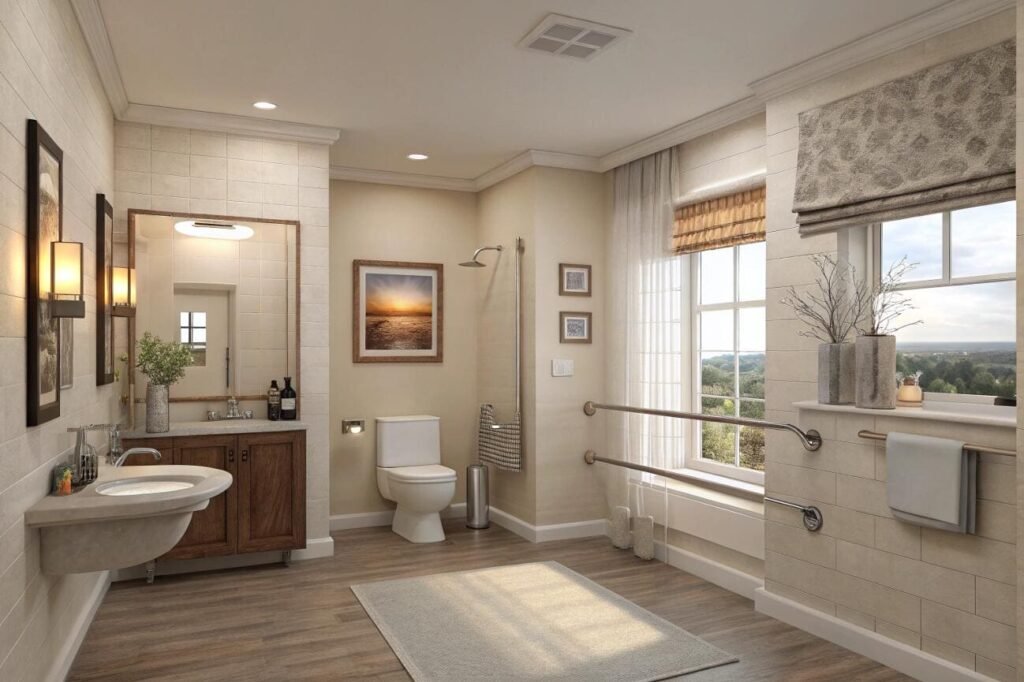You’re designing senior living spaces but struggling with window treatments that pose safety risks or are too difficult for elderly residents to operate. Traditional corded blinds create strangulation hazards, while heavy manual systems require strength and dexterity many seniors lack.
Cordless motorized blinds with large button controls and cellular honeycomb designs provide the safest window treatments for senior living facilities. These systems eliminate cord hazards, require minimal physical effort, and offer excellent privacy and light control. Battery-powered motors ensure operation during emergencies while reducing installation complexity in retrofit applications.
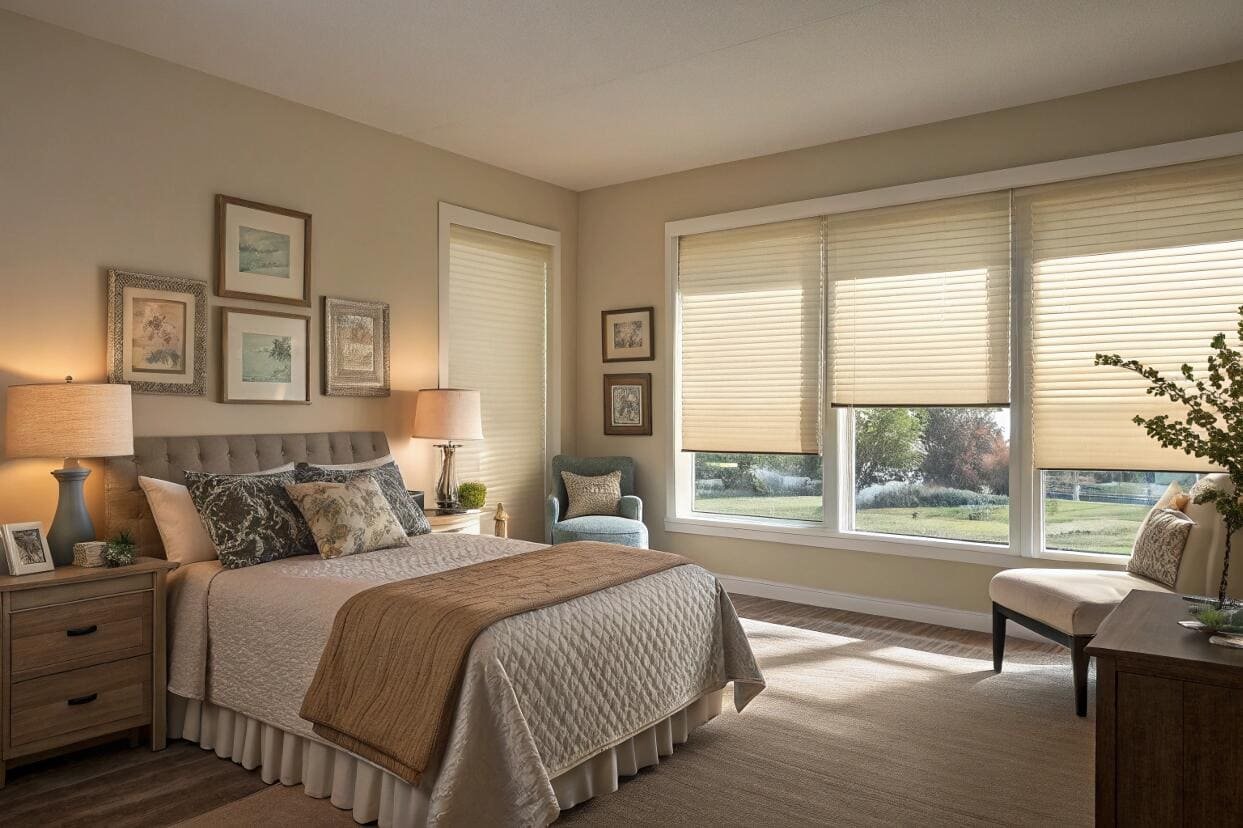
The aging population’s unique needs require specialized approaches to window treatment design. Safety, accessibility, and ease of use must take priority over traditional aesthetic considerations in senior living environments.
What blinds are best for seniors?
Elderly residents face multiple challenges with traditional window treatments including limited mobility, reduced grip strength[^1], and safety concerns with corded systems. The wrong choice can create daily frustration or serious safety hazards.
Cordless cellular shades with motorized operation provide optimal solutions for seniors. The honeycomb design offers excellent insulation and privacy while motorized controls eliminate physical strain. Large handheld remotes with simple button layouts accommodate reduced dexterity and vision challenges common in elderly populations.
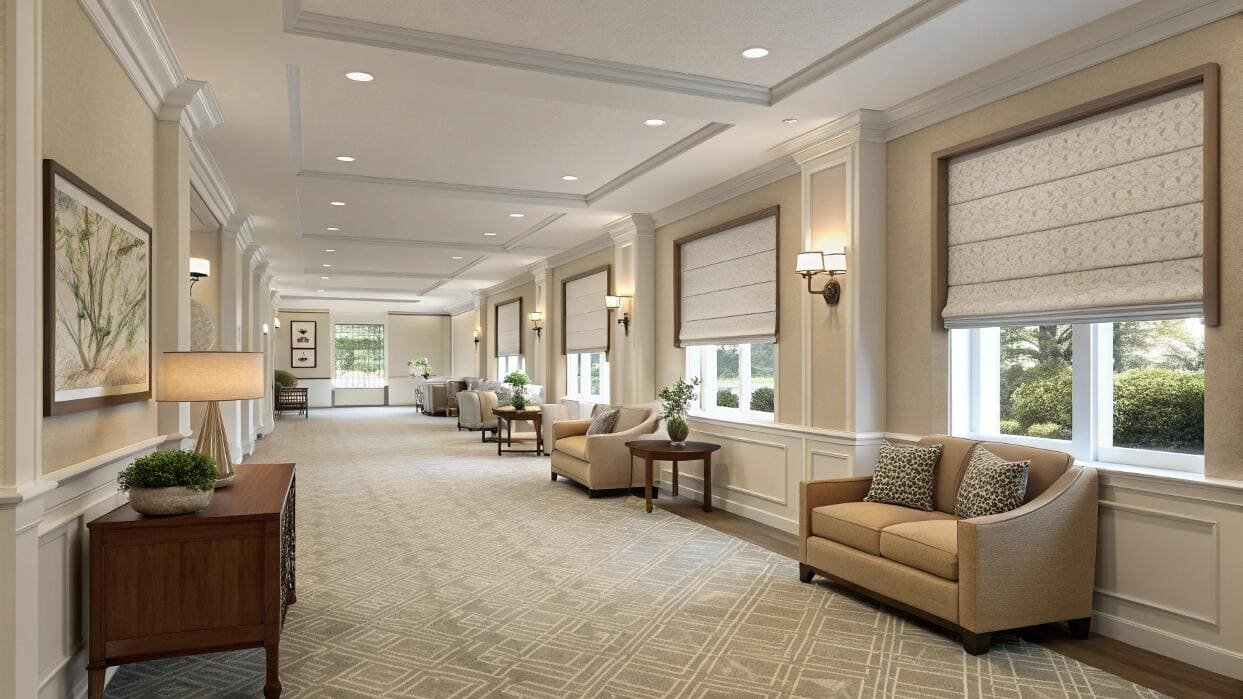
Safety represents the primary concern when selecting blinds for senior living facilities. Traditional corded blinds pose strangulation risks, particularly for residents with cognitive impairments who might become entangled. The Consumer Product Safety Commission has documented numerous incidents involving elderly residents and window treatment cords, making cordless systems[^2] essential for safety compliance.
Cellular honeycomb shades excel in senior applications due to their lightweight construction and excellent insulation properties. The honeycomb design traps air for superior temperature control, reducing energy costs while maintaining comfortable environments. These shades operate smoothly with minimal force required, accommodating residents with arthritis or limited hand strength.
Motorized systems eliminate the physical demands of manual operation entirely. Quality motors can lift even large cellular shades with the press of a button, making window control accessible to residents with severe mobility limitations. Battery-powered systems ensure operation during power outages, maintaining privacy and comfort when emergency generators may not power convenience systems.
Control interface design becomes crucial for senior applications. Large buttons with clear labeling accommodate vision challenges common in elderly populations. Some systems offer voice control integration[^3], allowing residents to adjust blinds through simple spoken commands. Programmable schedules reduce the need for daily manual adjustments while maintaining appropriate lighting patterns.
Installation considerations for senior facilities include mounting height and accessibility for maintenance. Inside-mount installations reduce protrusion hazards while providing cleaner aesthetics. Professional installation ensures proper motor sizing and reliable operation that facility staff can maintain with minimal specialized knowledge.
What blinds allow light but are private?
Senior living facilities need window treatments that provide privacy without creating dark, institutional environments. Natural light supports circadian rhythms and emotional well-being while privacy protects resident dignity and security.
Solar shades with 3-5% openness factor provide daytime privacy while maintaining natural light transmission and outside views. These fabrics block visibility from outside during daylight hours while allowing residents to see outdoors, supporting mental health through visual connection to nature and seasonal changes.
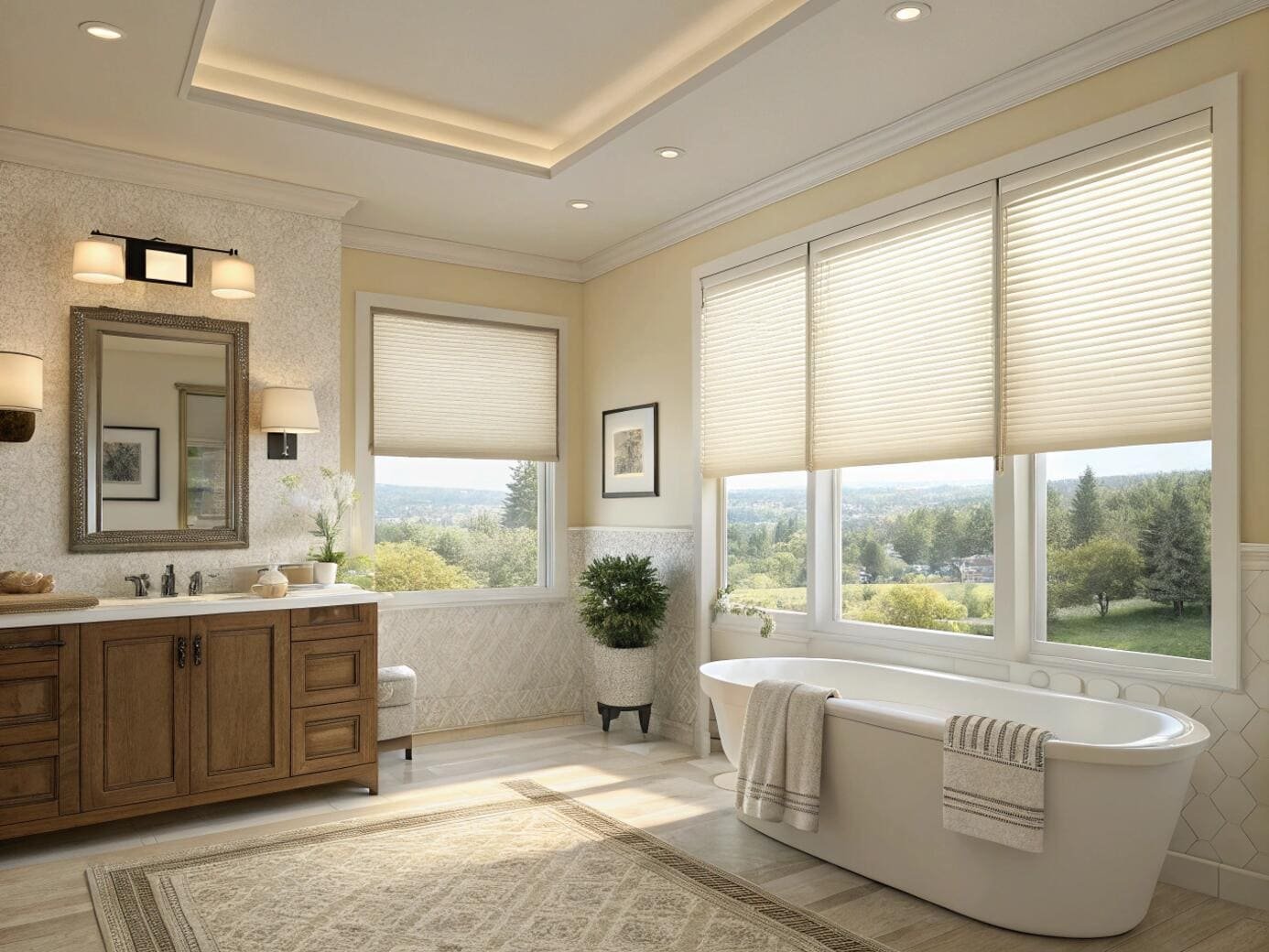
The openness factor in solar shades determines the balance between privacy and light transmission. A 3-5% openness provides excellent daytime privacy while maintaining clear outward visibility for residents. This configuration blocks most external views into living spaces while preserving the psychological benefits of outdoor connections that are crucial for elderly mental health.
Light quality affects senior well-being significantly. Natural light helps regulate sleep cycles that often become disrupted with age. Solar shades filter harsh glare that can be particularly problematic for elderly eyes while maintaining beneficial daylight levels. The filtered light reduces eye strain and creates more comfortable reading environments.
Privacy needs in senior facilities extend beyond basic visibility concerns. Residents require protection from curious passersby while maintaining connection to outdoor activities and weather patterns. Solar shades provide this balance effectively, allowing observation of seasonal changes, wildlife, and outdoor facility activities while preventing unwanted external observation.
Dual roller systems offer additional flexibility for senior applications. A solar shade handles daytime privacy and light control while a room-darkening shade provides complete privacy and darkness for sleep periods. This system accommodates varying resident needs throughout the day without requiring multiple adjustments or complex operation procedures.
Material considerations include easy cleaning and durability under high-use conditions. Senior facilities often experience more frequent cleaning requirements due to health regulations. Solar shade fabrics should resist staining and tolerate regular cleaning without degrading privacy or light-filtering properties. Anti-microbial treatments may be beneficial in healthcare environments.
What blinds don’t let people see in?
Complete privacy becomes essential in senior living bedrooms, bathrooms, and private areas where residents need protection from external observation. Traditional privacy solutions may be too complex or physically demanding for elderly operation.
Room-darkening cellular shades and motorized roller blinds with blackout fabrics provide complete privacy while maintaining ease of operation. These systems block all external visibility while offering simple control methods appropriate for residents with limited dexterity or cognitive challenges.
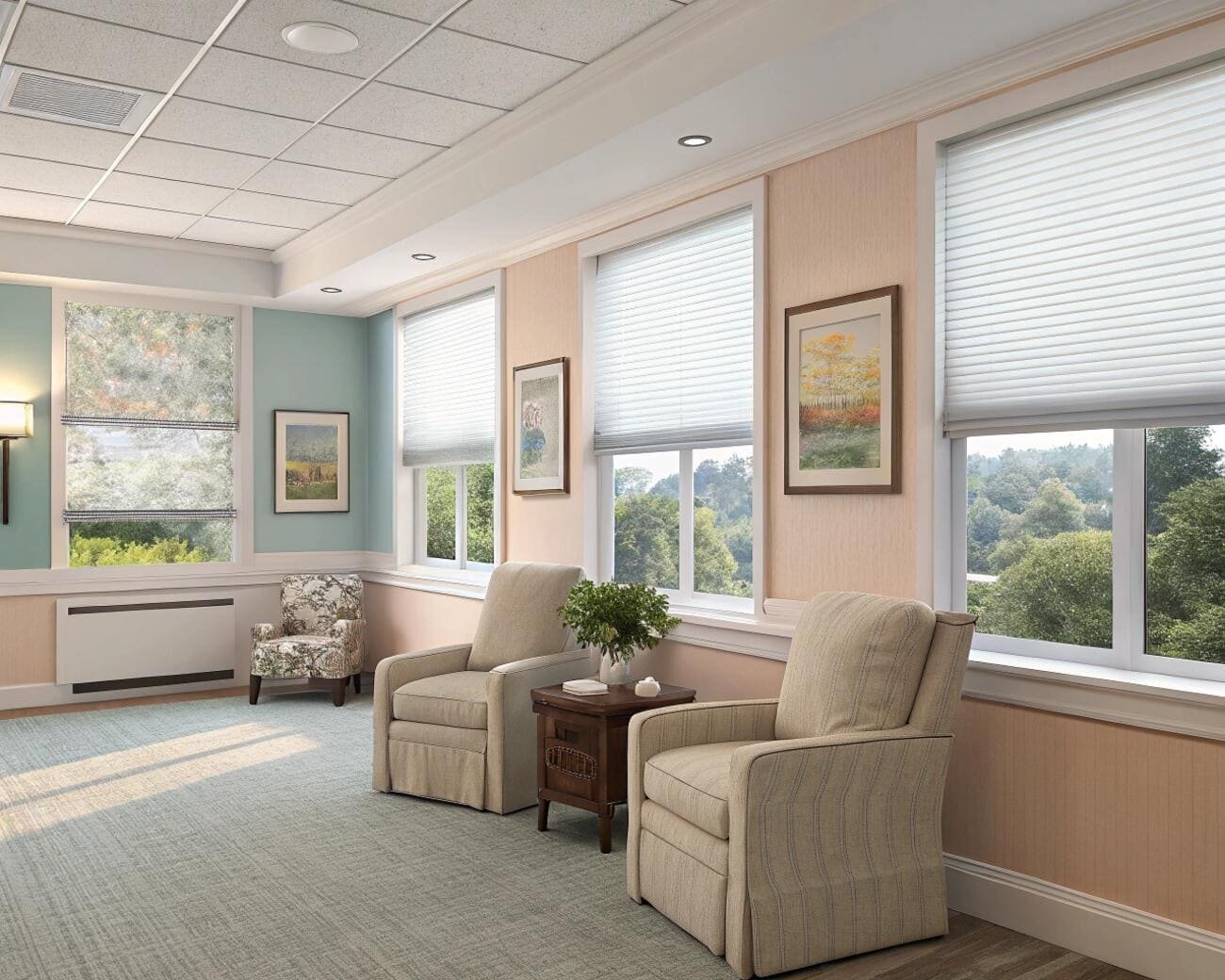
Blackout cellular shades represent the gold standard for senior living privacy applications. The multi-layered honeycomb construction eliminates light gaps while providing superior insulation. Single-cell designs offer basic privacy and insulation, while double-cell configurations provide maximum light blocking and thermal performance. Triple-cell options deliver ultimate privacy and energy efficiency for facilities in extreme climates.
Edge sealing becomes crucial for complete privacy in senior applications. Light gaps around shade edges can compromise privacy and create unsightly light leaks. Quality cellular shades include side channels or mounting systems that minimize these gaps. Professional installation ensures proper fit and maximum privacy protection.
Motorized blackout roller blinds offer another excellent privacy solution for senior facilities. These systems provide complete light and view blocking while requiring only simple button operation. Battery-powered motors eliminate the need for electrical modifications in existing buildings, simplifying installation and reducing costs.
Privacy requirements vary by facility area and resident needs. Bedrooms require complete privacy for dignity and sleep quality. Common areas may need adjustable privacy levels for different activities and times of day. Bathroom areas need permanent privacy solutions that don’t rely on resident operation. Administrative areas may require privacy during certain activities while maintaining visibility for safety monitoring.
Maintenance access affects privacy system selection in senior facilities. Systems requiring frequent adjustment or maintenance may not be appropriate for areas where residents cannot safely operate controls. Motorized systems with professional maintenance contracts ensure reliable privacy protection without burdening facility staff or residents with complex operational requirements.
How to make sure people can’t see through blinds?
Ensuring complete privacy requires understanding light transmission properties and potential privacy gaps in different blind configurations. Senior facilities must guarantee privacy protection regardless of lighting conditions or resident operational errors.
Proper installation with light gap elimination, appropriate fabric opacity ratings, and correct sizing ensures blinds provide complete privacy. Choose fabrics with zero light transmission, install with side channels or overlapping mounts, and select inside-mount configurations that eliminate edge gaps where possible.
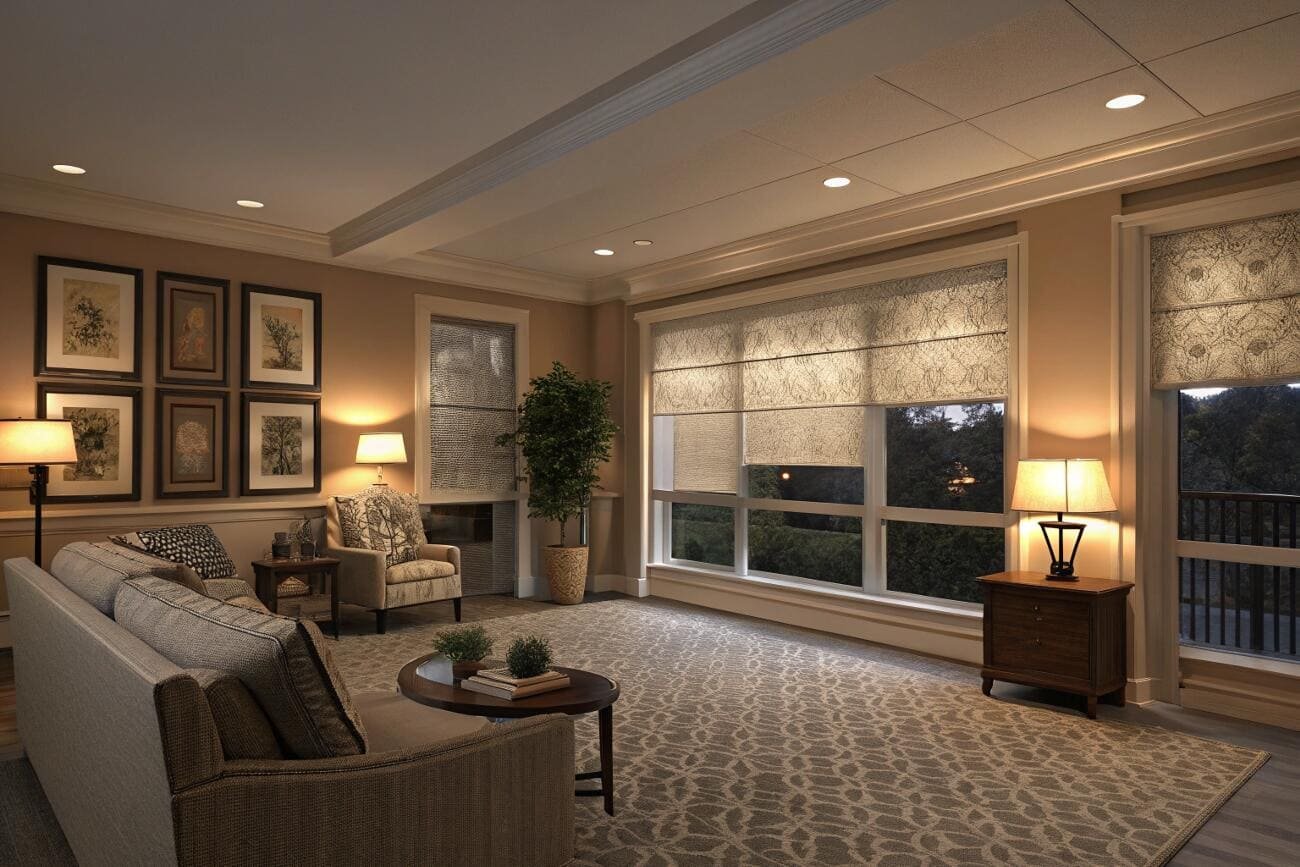
Fabric opacity ratings determine privacy effectiveness under different lighting conditions. Room-darkening fabrics block 85-95% of light transmission while blackout fabrics achieve 99%+ light blocking. For senior living applications, blackout ratings ensure privacy regardless of interior lighting levels or time of day. This becomes particularly important in bedrooms where residents may have lights on during evening hours.
Installation technique significantly impacts privacy performance. Inside-mount installations that fit precisely within window frames eliminate most edge gaps. Outside-mount installations can provide better privacy when combined with overlapping mounting that extends beyond window frame dimensions. Professional installers understand these techniques and can recommend optimal approaches for specific window configurations.
Edge sealing systems prevent privacy gaps that commonly occur with standard installations. Side channels guide shades or blinds to maintain contact with window frames throughout their operation. Magnetic or brush seals along shade edges eliminate gaps that might allow visual intrusion. These systems are particularly important in ground-floor rooms or areas with close neighboring buildings.
Layered privacy systems provide redundancy for critical applications. Combining solar shades for daytime privacy with blackout shades for complete privacy ensures protection under all conditions. This approach accommodates varying resident needs while guaranteeing privacy when required. Motorized dual systems allow easy switching between privacy levels without complex operation procedures.
Quality control during installation includes privacy testing under various lighting conditions. Professional installers verify privacy performance during day and night conditions to ensure specifications are met. This testing identifies potential privacy gaps before occupancy begins, avoiding embarrassing discoveries after residents move in.
What are the safest window treatments for seniors with mobility issues?
Mobility challenges affect a significant percentage of senior living facility residents, requiring window treatments that eliminate physical barriers while maintaining functionality. Safety considerations extend beyond operation to include potential hazards from the window treatment system itself.
Motorized cordless systems with large button remotes provide the safest solutions for mobility-impaired seniors. These eliminate reaching, pulling, and twisting motions while removing cord entanglement risks. Voice control integration offers hands-free operation for residents with severe mobility limitations.
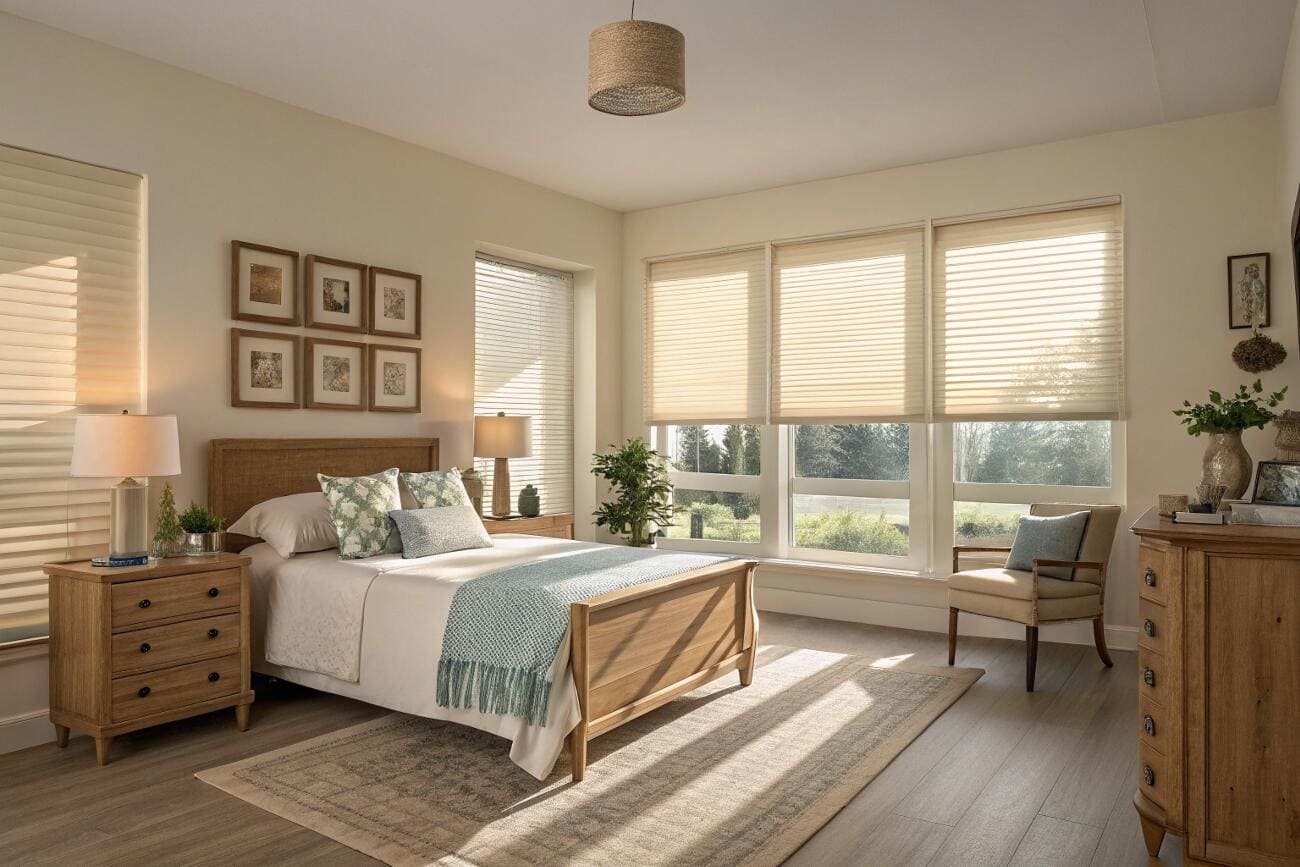
Physical operation requirements must accommodate various mobility limitations common in senior populations. Arthritis affects grip strength and fine motor control, making small controls or complex adjustment mechanisms unsuitable. Motorized systems eliminate these physical demands entirely while providing precise control through simple button interfaces designed for limited dexterity.
Reach limitations affect window treatment placement and control location. Wall-mounted controls should be positioned within ADA-compliant reach ranges[^4] while avoiding interference with mobility aids. Handheld remotes provide flexibility for residents with varying mobility capabilities. Some residents may use wheelchairs, walkers, or other assistive devices that affect their ability to reach window treatment controls.
Safety hazards from window treatment hardware require careful consideration. Protruding components can create collision risks for residents with vision impairments or mobility aids. Smooth, rounded hardware reduces injury risks from accidental contact. Cordless systems eliminate entanglement hazards that pose particular risks to residents with cognitive impairments who might not recognize dangerous situations.
Emergency operation capabilities ensure window treatment functionality during power outages or system failures. Battery backup systems maintain motorized operation when primary power fails. Manual override mechanisms allow facility staff to operate systems during emergencies or maintenance periods. These features become crucial in assisted living environments where residents cannot address system failures independently.
Voice control integration represents an emerging solution for residents with severe mobility limitations. Smart home integration allows window treatment control through simple voice commands, eliminating physical interaction entirely. These systems work with existing smart speakers or dedicated voice control devices designed for senior applications.
How to choose cordless blinds for senior living facilities?
Cordless blind selection requires balancing safety, functionality, and durability in high-use senior living environments. The elimination of cords addresses multiple safety concerns while simplifying operation for residents with varying capabilities.
Select cordless cellular or roller shades with spring-loaded lift mechanisms for manual operation, or motorized systems for completely effortless control. Prioritize brands with proven reliability in commercial applications and warranty coverage appropriate for institutional use in senior living facilities.
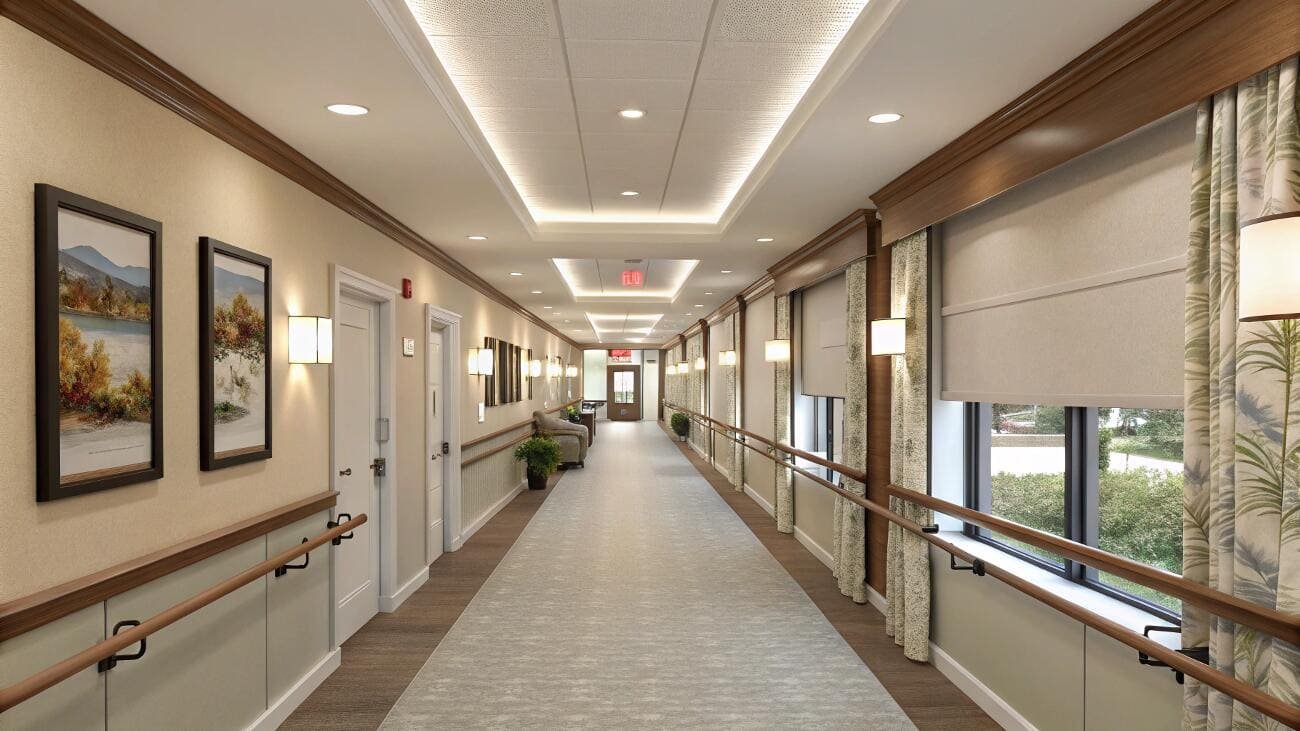
Spring-loaded lift mechanisms in cordless cellular shades provide smooth operation with minimal force requirements. Quality spring systems balance shade weight precisely, allowing easy raising and lowering with gentle pulling motions. These systems work effectively for lightweight to medium-weight fabrics typical in senior living applications. Proper spring tension adjustment during installation ensures optimal performance throughout the shade’s operational life.
Durability considerations become paramount in senior facility applications. High-use environments with frequent cleaning requirements demand robust construction and materials. Commercial-grade cordless systems include reinforced lift mechanisms and durable fabrics that withstand institutional cleaning protocols. Warranty coverage should reflect commercial use expectations with coverage periods appropriate for facility budget planning.
Control mechanism design affects resident usability significantly. Cordless systems may use bottom rail operation, side handles, or integrated lift systems. Bottom rail operation requires minimal learning but may be difficult for residents with limited reach. Side handles provide better ergonomics but may complicate installation. Integrated lift systems offer the smoothest operation but typically cost more.
Size limitations affect cordless system suitability. Spring-loaded mechanisms work effectively for windows up to certain sizes before becoming difficult to operate. Large windows may require motorized systems to maintain easy operation. Professional consultation helps determine optimal cordless solutions for specific window dimensions and resident capabilities.
Maintenance requirements vary significantly between cordless system types. Spring mechanisms may require periodic adjustment or replacement as tension changes over time. Motorized cordless systems need battery maintenance or electrical service but eliminate mechanical wear issues. Facility maintenance staff capabilities should influence system selection to ensure long-term reliability and resident satisfaction.
Which lightweight window treatments work best for elderly residents?
Weight reduction in window treatments benefits elderly residents by reducing operational force requirements while maintaining functionality and aesthetics. Lightweight systems also reduce stress on mounting hardware and window frames in aging buildings.
Lightweight cellular fabrics, thin roller shade materials, and aluminum mini-blinds provide excellent functionality with minimal weight. Single-cell honeycomb shades weigh 50-70% less than traditional pleated shades while offering superior insulation and privacy performance for senior living applications.
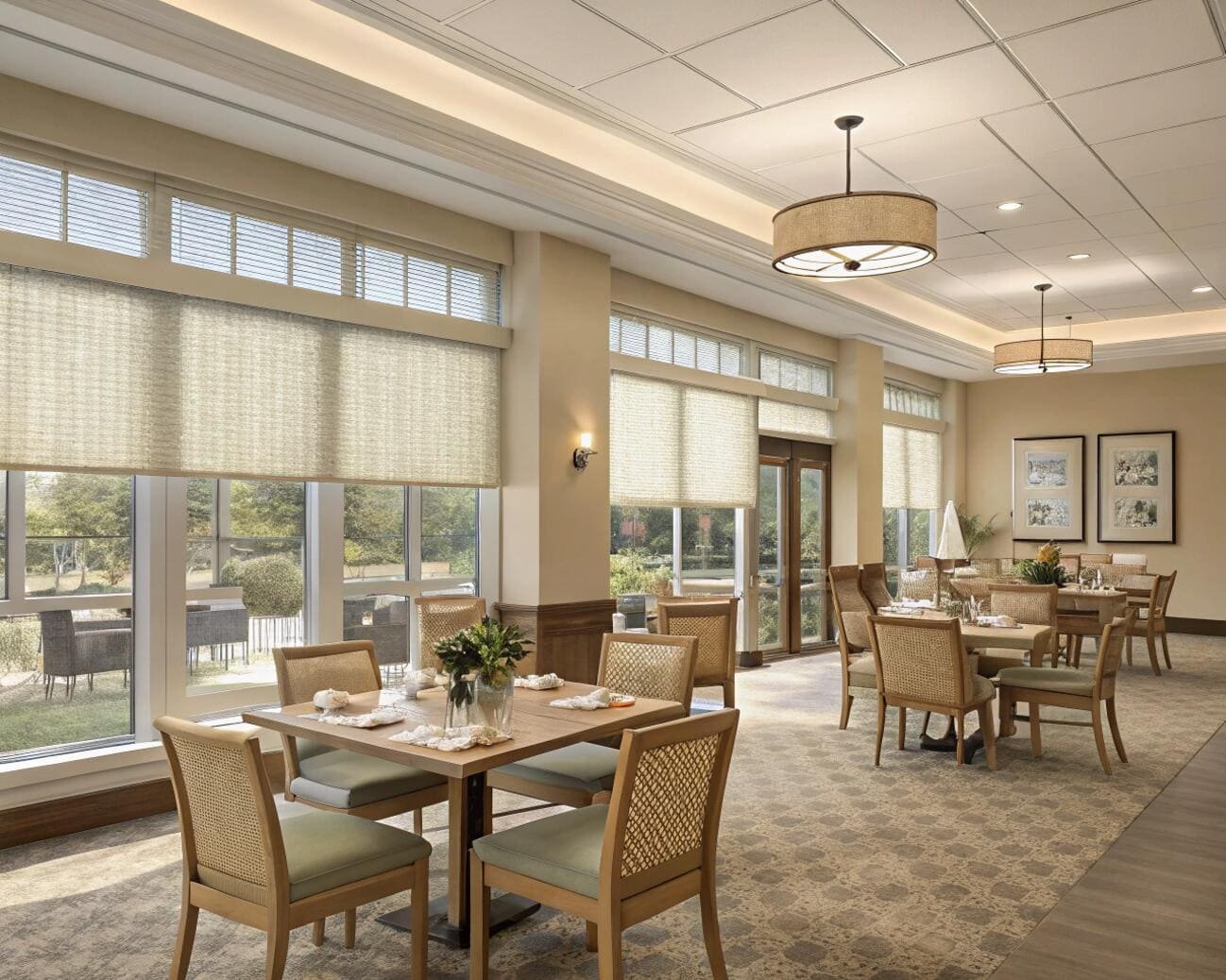
Cellular shade construction offers the best weight-to-performance ratio for senior applications. Single-cell designs provide substantial weight reduction compared to traditional pleated or roman shades while maintaining excellent light control and insulation properties. The honeycomb structure creates strength through geometry rather than material weight, resulting in durable yet lightweight window treatments.
Fabric selection significantly impacts final weight and operational requirements. Thin polyester fabrics reduce weight while maintaining opacity and privacy characteristics. Specialty lightweight fabrics designed for senior applications optimize weight reduction without sacrificing performance. Some manufacturers offer ultra-light cellular fabrics specifically engineered for easy operation by elderly users.
Roller shade systems benefit from lightweight fabric selection and optimized hardware design. Thin solar screen fabrics provide excellent sun control with minimal weight. Lightweight blackout fabrics offer privacy and light control without the bulk associated with traditional heavy blackout materials. Spring-loaded or motorized lift systems compensate for any operational challenges while maintaining lightweight benefits.
Mini-blind alternatives using lightweight aluminum slats provide traditional blind functionality with reduced weight. Thin-profile slats maintain light control capabilities while reducing overall system weight significantly. Cordless lift systems eliminate cord weight and operational complexity while maintaining the familiar blind operation that some senior residents prefer.
Installation considerations for lightweight systems include reduced structural requirements and simplified mounting procedures. Lightweight systems place less stress on window frames and mounting hardware, extending system life and reducing maintenance requirements. Standard mounting brackets often suffice where heavier systems might require reinforcement, simplifying installation and reducing costs.
What motorized options are ideal for assisted living environments?
Assisted living environments require motorized window treatment systems that balance resident independence with safety and institutional durability requirements. These systems must accommodate varying resident capabilities while providing reliable operation for facility staff.
Battery-powered DC motors with large button remotes and programmable scheduling provide optimal solutions for assisted living facilities. These systems offer quiet operation below 40 decibels, extended battery life, and simple controls appropriate for residents with cognitive or physical limitations while maintaining professional-grade reliability.
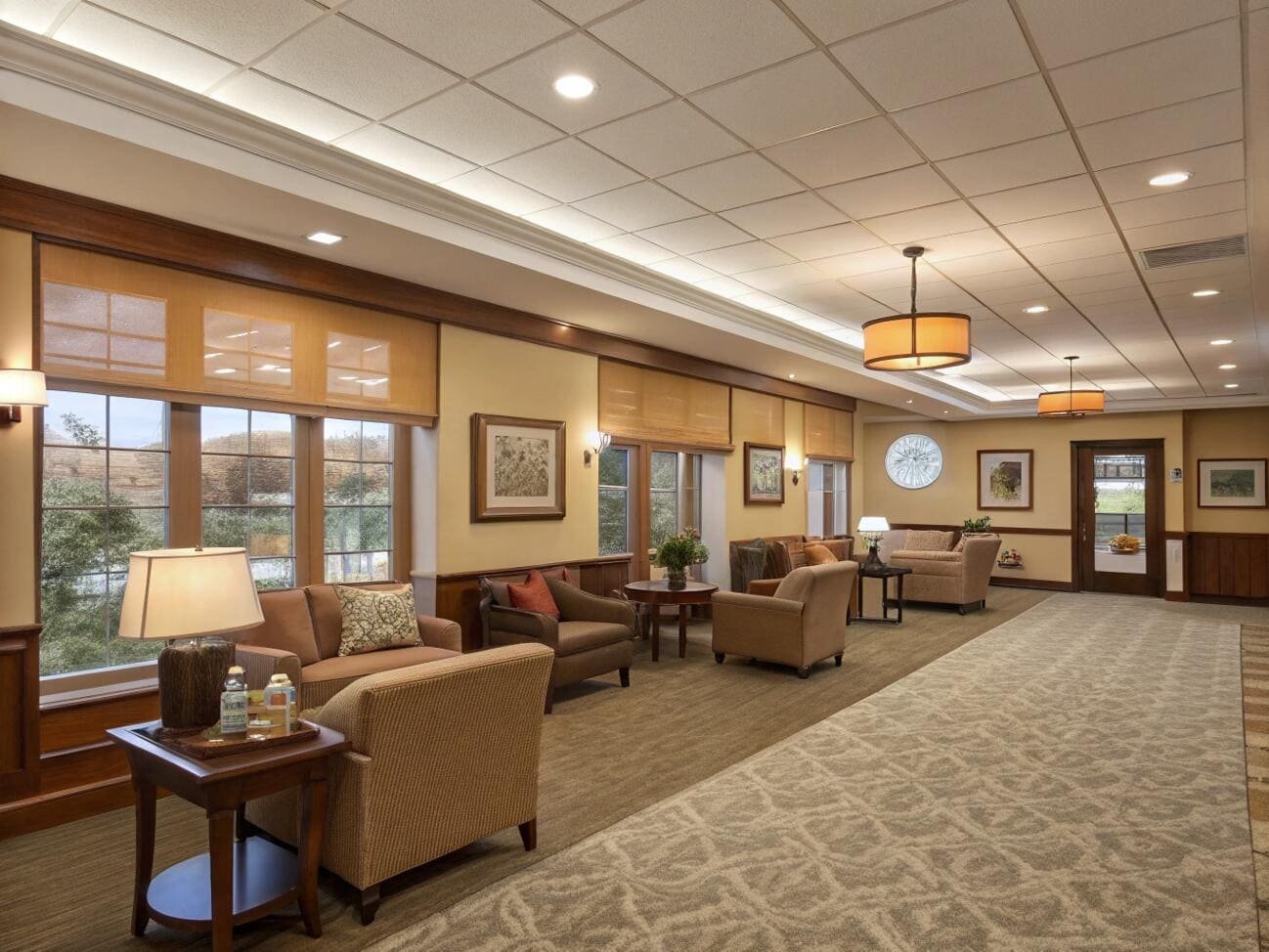
Battery-powered systems eliminate electrical infrastructure requirements while providing reliable operation for extended periods. Modern lithium-ion batteries operate quality motorized blinds for 6-12 months between charges, depending on usage frequency. This extended battery life reduces maintenance demands on facility staff while ensuring consistent operation for residents. Solar charging options extend battery life further while reducing maintenance requirements.
Quiet operation becomes essential in assisted living environments where residents may be sensitive to noise disruption. Quality DC motors operate below 40 decibels, quieter than normal conversation levels. This quiet operation prevents sleep disruption during programmed adjustments and allows discretionary use without disturbing neighboring residents or facility activities.
Control interface design must accommodate varying cognitive and physical capabilities among assisted living residents. Large buttons with clear labeling help residents with vision impairments or cognitive challenges. Simple up/down operation eliminates confusion while providing essential functionality. Some systems offer pictorial controls or voice activation for residents who cannot use traditional button interfaces effectively.
Programmable scheduling reduces daily operational demands on both residents and facility staff. Automated morning opening and evening closing schedules maintain appropriate lighting patterns without requiring individual resident action. Seasonal adjustments can be preprogrammed to accommodate changing daylight patterns. Emergency override capabilities allow facility staff to control all systems during safety situations or maintenance periods.
Reliability requirements in assisted living environments exceed typical residential applications. Systems must operate consistently with minimal maintenance intervention while serving residents who cannot troubleshoot operational issues independently. Commercial-grade motors and controls designed for institutional use provide the reliability needed for successful assisted living applications.
Group control capabilities allow facility staff to manage multiple windows simultaneously during daily routines or emergency situations. Master controls in nursing stations enable staff oversight while maintaining individual room control for resident independence. This dual-control approach balances resident autonomy with facility operational requirements.
Extended FAQ Section
What window treatments prevent falls in senior living facilities?
Falls represent a leading safety concern in senior living facilities, with window treatments potentially contributing to trip hazards or creating unstable surfaces during operation attempts.
Cordless motorized systems mounted securely above reach eliminate fall risks by removing cords, chains, and manual operation requirements. Wall-mounted controls positioned within safe reach ranges and remote controls eliminate the need for residents to approach windows or reach above their capabilities, significantly reducing fall potential.
Inside-mount installations keep all components within window frames, eliminating protrusions that could cause trips or collisions. Motorized systems remove the need for residents to reach, stretch, or lean toward windows during operation. Battery-powered systems avoid electrical cords that could create additional trip hazards in living spaces.
Professional installation ensures secure mounting that won’t fail under normal use conditions. Quality mounting hardware and proper installation techniques prevent system failures that could create safety hazards. Regular maintenance schedules identify potential issues before they become safety risks for elderly residents.
How do you clean window treatments in senior care facilities?
Cleaning requirements in senior care facilities exceed typical residential standards due to health regulations and infection control protocols requiring frequent sanitization and maintenance.
Antimicrobial fabric treatments and smooth, non-porous surfaces facilitate effective cleaning in senior care environments. Cellular shades with washable fabrics and roller blinds with vinyl or polyester materials allow regular cleaning without performance degradation. Removable fabric components enable thorough cleaning while maintaining system operation.
Cleaning frequency in senior facilities often requires weekly or bi-weekly attention depending on facility policies and resident needs. Window treatments must tolerate cleaning chemicals used in healthcare environments without fading, degrading, or losing functionality. Some fabrics include antimicrobial treatments that resist bacterial growth between cleaning cycles.
Removable components allow thorough cleaning without system replacement. Some cellular shades feature removable fabric sections that can be machine washed or professionally cleaned. Roller shade systems with removable fabric allow complete sanitization while maintaining motor and hardware components in place.
Professional cleaning services familiar with senior care requirements understand appropriate cleaning methods and chemicals for different window treatment materials. They can provide maintenance schedules that comply with facility regulations while extending system life and maintaining appearance standards expected in quality senior living environments.
What are the best colors for senior living window treatments?
Color selection affects both functionality and psychological well-being in senior living environments, with certain colors providing better visibility, safety, and emotional support for elderly residents.
Light neutral colors like cream, beige, and soft gray provide excellent light reflection while offering calming environments for senior residents. These colors maximize natural light benefits while providing sufficient contrast for residents with vision impairments to identify window treatment boundaries and controls safely.
High contrast between window treatments and surrounding walls helps residents with declining vision identify window locations and operate controls safely. Light-colored treatments against darker walls or dark treatments against light walls provide visual definition that supports safe navigation and operation.
Warm color temperatures in neutral tones support emotional well-being and create welcoming environments that feel homelike rather than institutional. Cool colors may feel sterile or unwelcoming in senior living spaces where residents spend significant time. Earth tones and soft pastels provide variety while maintaining appropriate psychological comfort levels.
Color consistency throughout facilities reduces confusion for residents with cognitive impairments while maintaining design cohesion. Similar color palettes in different areas help residents navigate facilities more easily while creating familiar, comfortable environments that support their sense of security and well-being in their living spaces.
Conclusion
Safe window treatments for senior living facilities prioritize cordless motorized systems with simple controls and reliable operation. These solutions eliminate safety hazards while providing comfortable, private environments that support resident independence and well-being in assisted living and senior care settings.
Enhance Your Senior Living Facility with Safe Window Solutions
Transform your senior living spaces with window treatments designed specifically for elderly safety and comfort. Our specialized systems eliminate cords, provide easy operation, and meet institutional durability requirements while maintaining the homestyle aesthetics your residents deserve.
Get comprehensive specifications for senior-safe window treatments, safety compliance documentation, and professional installation guidance tailored to assisted living and senior care facilities. Our team understands the unique requirements of senior living environments and provides solutions that prioritize resident safety and staff efficiency.
Connect with our senior living specialists for your custom safety solution:
info@velablinds.com
Create safer, more comfortable environments for your senior residents today.
---
[^1]: Find out which options are easiest for seniors to operate without straining.
[^2]: Discover how cordless systems enhance safety and ease of use for seniors.
[^3]: Learn how voice control can simplify window treatment operation for seniors.
[^4]: Understand the importance of ADA compliance in ensuring accessibility for seniors.Partner with VelaBlinds for Your Next Project
Smart window treatments shouldn’t be complicated. After working with 500+ distributors and contractors worldwide, I’ve streamlined the process to get you quality products, competitive pricing, and reliable support – every time.
Why project professionals choose VelaBlinds:
- ✅ Fast, Accurate Quotes – Detailed specs and pricing within 24 hours
- ✅ Transparent Pricing – No hidden fees, volume discounts clearly outlined
- ✅ Quality Assurance – Direct partnerships with certified OEM manufacturers
- ✅ Project Support – Dedicated account manager from quote to delivery
Start your next project:
📧 Quick Quote: Send your requirements to info@velablinds.com
📱 Direct Contact: WhatsApp +86 137 2012 8317
🌐 Browse Solutions: https://velablinds.com/
📁 Product Resources: Access spec sheets, catalogs & project files
Jimmy Chen, Founder
"I built VelaBlinds to solve the real challenges I faced as a project buyer – long lead times, unclear specs, and unreliable suppliers. Let’s discuss how we can power your projects with smarter blinds."
Serving distributors and contractors across North America, Europe, and Australia since 2018.

